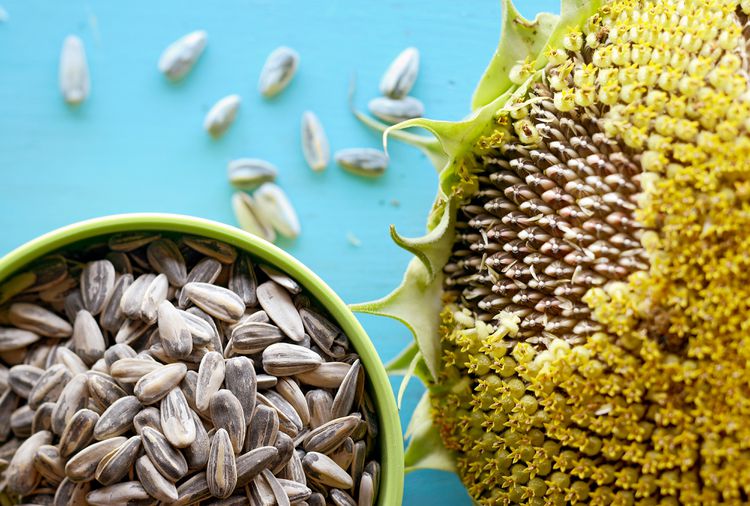Tall, colorful sunflowers always stand out in summer gardens. And when those striking flowers fade, they'll produce edible seeds that are among the finest snack foods you can grow in your garden. Knowing when and how to harvest sunflower seeds takes some practice, but these tips will help you pick your sunflowers when the seeds are at peak flavor.
When to Harvest Sunflower Seeds
If you inspect the back of sunflower seed packets, you’ll notice they usually include information about “days to maturity.” However, this typically refers to when sunflower plants will bloom. Most seed packets don’t provide any information about when the sunflower seeds will be ready to harvest.
Most sunflower varieties bloom in about two to three months, but sunflower seeds take a month to mature after the flowers open or 80 to 140 days after sowing. The sunflower seeds can be harvested from July through October, depending on when you planted the sunflower seeds and the varieties you're growing.
How to Tell When Sunflower Seeds Are Ready to Harvest
Knowing when to harvest sunflower seeds is a bit of a balancing act. Harvest them too early and you end up with small and tasteless kernels; if you pick too late, birds and other wildlife might beat you to the harvest. What’s more, some sunflower varieties mature faster than others, but there are signs you can look for when deciding if your sunflower seeds are ripe.
As sunflowers mature and the seeds develop, the sunflower blooms dry out and droop on their stems, and the plant’s leaves begin to yellow. If you inspect the back of sunflower blooms, you’ll notice that mature flowerheads turn from green to yellowish-brown, and the plant’s petals wither and fall off. These are all key signs that your sunflowers are ready to be picked.
How to Harvest Sunflower Seeds
When harvest time arrives, growers have two basic harvesting options for sunflower seeds. Seeds can be thoroughly dried on the plant or harvested early and dried indoors. Outdoor drying usually yields slightly more flavorful seeds; however, allowing seeds to mature fully on the plant increases the chances that birds gobble up the seeds before you get a chance to pick them.
If you prefer to dry sunflower seeds indoors, harvest the sunflowers when the backs of the flowerheads turn from green to yellow. To harvest, cut the sunflower stems with a sharp knife or pruners about 6–12 inches below the flowerhead, remove any remaining leaves, and bundle two to three sunflower stems together with twine. Hang these sunflower bundles upside down in a dark, well-ventilated space until they’re completely dry, and the back of the flowerheads turn brown.
If you’d rather dry sunflower seeds outdoors, cover the sunflower blooms with paper bags, cheesecloth, or fine mesh fabric as soon as the plant’s petals begin to wilt. This protects the sunflower seeds from hungry birds as the seeds dry in the sun. When the back of the sunflower blooms turn brown, snip off the flowerheads and bring them indoors to collect the seeds.
Once you have mature sunflower heads, the next step is removing the seeds. Grab a large bowl or bucket and rub the sunflower seeds off the flowers with your thumb or a brush. You can also rub two of the heads together to help dislodge the seeds. Ripe seeds should be plump and well-formed, and they should separate easily from the flowerheads as you work. If the seeds don’t seem ripe, hang the sunflowers to dry for a few more days.
How to Roast and Store Fresh Sunflower Seeds
Although you can eat raw homegrown sunflower seeds right after harvesting, roasting the seeds enhances their flavor and makes the hulls easier to remove.
To roast sunflower seeds, spread out the fresh seeds in a single layer on a baking sheet and bake them at 400°F for five minutes. After they are roasted, sunflower hulls should crack open easily, but if they’re still hard to open, roast the seeds at 2-minute intervals until the seeds are dry. Be careful not to overcook or brown the sunflower seeds, as this diminishes their flavor.
To roast and salt sunflower seeds, place 1 cup of raw sunflower seeds in a quart of water with 2 to 4 tablespoons of salt. Bring the water to a boil on the stove, turn down the heat, and simmer the seeds for 15 minutes. Drain the seeds, spread them on a baking sheet in a single layer, and bake them at 400°F for 10 to 15 minutes until they are dry.
Both raw and roasted sunflower seeds can be stored in air-tight containers in your pantry for about 2 to 3 months. For extended storage, keep sunflower seeds in your freezer, where they’ll stay fresh for a year. While sunflower seeds are hard to resist snacking on, don’t forget to save a few raw sunflower seeds to plant in next year’s garden.




















